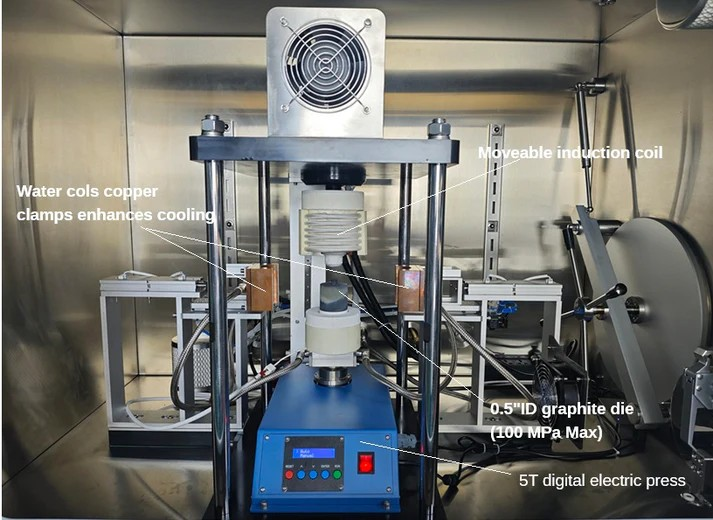The Rapid Heating Press (RHP) is an advanced powder consolidation technique that combines high heating rates with a simple, scalable design. Unlike Spark Plasma Sintering (SPS), which drives pulsed current directly through the compact—sometimes inducing localized electrochemical reactions—RHP uses induction or resistance heating of the graphite die. This makes RHP compatible with both conductive and non-conductive powders, ensuring more uniform temperature distribution and avoiding electrochemical side effects.
A key advantage of RHP lies in its ability to integrate active fast cooling, a function generally not feasible in SPS. In SPS, the large thermal inertia of the graphite tooling stores significant heat, which prevents rapid quenching. By contrast, in RHP the die serves mainly as a susceptor for induction heating, so less thermal mass is retained. This enables controlled fast cooling, which is critical for:
- Stabilizing metastable and non-equilibrium phases
- Preserving ultrafine or amorphous microstructures
- Reducing thermal damage
- Improving reproducibility in sensitive materials
In addition, while SPS systems are rarely compatible with glove-box environments, RHP can be directly integrated with a glove-box chamber. This allows processing under ultra-low oxygen and moisture conditions, expanding the accessible material range to include air-sensitive or reactive powders such as rare-earth alloys, hydrides, carbides, and nitrides.
Together, these features make RHP a powerful alternative to SPS, offering fast and uniform heating, controllable rapid cooling, glove-box compatibility, scalability, and lower system cost.
MTI’s GBF-1700-RHP4 Model
The GBF-1700-RHP4 from MTI Corporation embodies these advantages, integrating both fast cooling capability and glove-box operation into a single system for advanced material synthesis.

Main Components:
- Induction Heater : 15 kW power supply
- Frequency : 30–80 kHz (fixed)
- Working Temperature : 1000–1600 °C
- Heating Rate : up to 5 °C/s (depending on temperature range)
- Cooling Rate : up to 14 °C/s (depending on temperature range)
- Temperature Control Accuracy : ± 5 °C
- Electric Uniaxial Press : up to 5 T load
- Glove-Box Enclosure : <1 ppm O₂ and H₂O (high-purity inert atmosphere)
- Graphite Supporting Rods : 0.5” I.D. (Internal Diameter) splitable graphite die

Typical Synthesis Workflow
- Loading: Introduce the graphite die, tungsten carbide molds, and sample powder.
- Purging: Transfer the components through the glove-box antechamber to ensure an inert atmosphere.
- Mold Setup: Install the mold and place the powder inside.
- Positioning: Lower the upper pressing rod to the correct position.
- Pressing: Apply uniaxial pressure (up to 5000 kg).
- Heating: Position the induction coil around the die, set the heating program, and begin heating.
- Peak Temperature: Once the target temperature is reached, lift the coil away.
- Rapid Cooling: A water-cooled copper mold clamps the die to achieve rapid cooling.
- Release: After cooling, release the copper mold and recover the sample.
Summary
By combining rapid induction heating, active fast cooling, and glove-box integration, the GBF-1700-RHP4 enables material synthesis under conditions not accessible to SPS. It provides a versatile route for producing high-performance materials with non-equilibrium phases, preserved fine microstructures, and improved reproducibility, while remaining scalable and cost-effective.
Find more details : Rapid Heating & Cooling Pressing Furnace up to 1600°C & 100 MPa in a G – MTI Online Store
Write to us for any questions: contact@accessr-energy.eu


